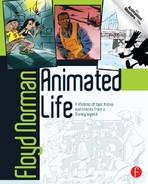26 |
Out the Door
Getting dismissed is some times downright strange.
It's never fun to lose your job. Getting your dismissal papers can be downright traumatic or just plain odd. Let me tell you about the unique way Walt Disney said “bye-bye” to the artists and writers whose ideas failed to impress him. This was a time when there was no Human Resources Department to act as a buffer, and getting sacked was an art in itself.
When we were kids back in the day, it was not unusual to see a number of animation veterans arrive at Walt Disney Studios charged with a task. They were there to develop a new cartoon property for the Old Maestro himself. The artists were usually given office space on the second or third floor of the Animation Building. If you've ever had the opportunity to visit the studio, you'll remember that the writers and story artists worked in large spacious rooms with ample room for storyboards and such.
Sometimes the creators were industry legends such as T. Hee or Robert (Bobe) Cannon and even Chuck Jones. They and many other talented veterans worked on film ideas for the boss that sometimes and sometimes not moved into production. Walt knew that ideas had to be developed and natured to keep his Animation Department chugging along. However, that didn't necessarily mean that your brilliant idea would move into production. Walt Disney had a way of quickly making up his mind, and should your idea fail to inspire him, you knew pretty quickly the party was over.
Here's how the process worked. An industry professional would move into an upstairs office and would spend the first few days visiting and chatting with old friends and colleagues. Then the pro would knuckle down and get to work creating script pages, storyboards, and character designs. After a few weeks had passed, the presentation would be ready, and a pitch with Walt Disney would be set up.
Because Walt Disney was a busy man, it might have been another two weeks or so before the Old Maestro would have room on his calendar. Eventually, the day would arrive, and Walt's distinctive loud cough could be heard in the hallway. The day of reckoning was at hand, and Walt and a number of “big shots” would gather around a series of storyboards as the creator made his pitch.
An hour or two later, Walt Disney would get up from his chair and thank the artist for all his fine work and quickly exit the room. Did the pitch go well, or was it a bust? Will I continue, or am I sacked? In a few days, the answer would be provided.
Phone calls, visits by production personnel, and maybe even a move to another office was a pretty good indication that your project was being tracked for further development and maybe even production. However, should your phone sit silently on your desk and visitors avoid your office, you might have cause for concern.
Having seen this scenario played out several times, I realized that this was Walt's method of saying goodbye. It was a way of telling the artist or writer that it was time to move on. No junior executive brought the bad news. No envelope with a pink slip was shoved under your door, nor were you ever told to vacate your space. Nope! You continued to receive your paycheck week after week while you sat in your empty office with nothing to do.
You might say, a paycheck is a paycheck—so what's the harm in taking a free ride? Well, men and women have their pride, and sitting in a room with absolutely nothing to do eventually takes its toll. Unable to take it any longer, the artist would gather up his personal belongings, say his goodbyes, and walk out the door to the parking lot. After a number of lonely weeks, the artist has essentially “fired himself.”
Finally, there were a few employees whom Walt Disney actually did fire. However, the sacking they received was for indiscretions other than creating a lackluster story. The Old Maestro had little patience with prima donnas or those who exhibited poor public behavior. Many of the young actors in present-day Disney would have long since been shown the door had Walt been around.
Of course, times have changed, and when I look back on the 1960s, I still feel sorry for that unfired artist or writer. Because he's sitting all alone in his huge office and he's staring at the telephone. The worried writer is waiting for a call from Walt Disney. However, it's a telephone call that sadly will probably never come.

